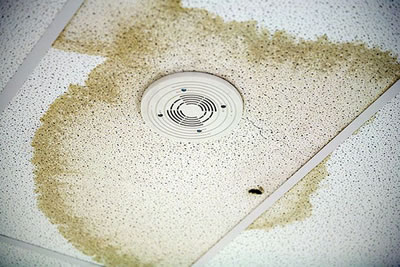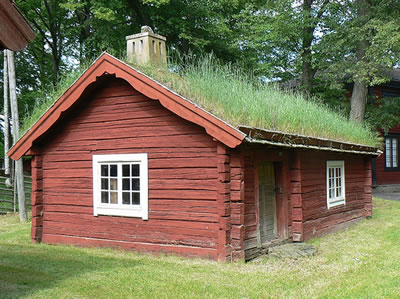Escaped water or a constant dampness can pose a real threat to the integrity of your property; your timber areas may rot, insulation may lose its effectiveness and if left untreated, may ultimately result in a big job to fix.
Unfortunately, fixing a roof leak is not always a simple matter as unless it has reached an advanced stage the source of the problem may not always be obvious.
We take a look at some of the most likely places you may find a roof leak along with a checklist of the tell-tall signs to watch out for.
How to spot a leak
You may imagine that a leak involves water gushing through your living room ceiling but in the vast majority of cases, you will have to be eagle-eyed to spot there is a problem.
Although many leaks have the potential to get worse and slowly spread throughout the house, damaging walls and ceilings en route, many are hidden away and can only be found if you are specifically looking.
For this reason, it’s a good idea to carry out periodic checks to see if you can spot any tell-tale signs that you might have a problem.
Here are a few things to watch out for:
- tea-stained spots or marks on the ceiling
- black stains around the chimney or roofing deck – can indicate the start of mildew or mould
- oddments of shingle in the garden
- rotting wood or peeling paintwork around the skylights
- scraps of roofing material in the downspout
- pinholes of light in your loft roof – this could indicate a potential gap through which leaks could travel
- buckled roof shingles
The above list is by no means a comprehensive guide but should help give you an idea of the kinds of signs which should set alarm bells ringing
Tracking down the source
If you spot any of the above in your property, there’s a good chance that you have a leak. Don’t be tempted to leave it until matters get worse because the fix could end up becoming very expensive; leaks can do a lot of damage behind the scenes.
The bad news is that the source of the leak can be very difficult to find, especially as the spot where they choose to manifest can be some distance from the actual point of entry.
You may be lucky enough to have an obvious an visible problem such as missing roof tiles but in the vast majority of cases you will need to become a DIY detective to track down the original damp patch.
Going up into the loft space can often be very fruitful; any areas where there are black stains generally indicate the present of mould or mildew. This can help to narrow down where the leak is coming from.
One word of warning before you embark on a determined hunt through your house: you may find signs of water staining on your ceiling without a leak being present. This can be due to condensation instead.
It can be helpful to learn how to identify a condensation problem because it will also need attention, even if you don’t have a leak which needs fixing.
A condensation stain will appear on the ceiling near an exterior wall, usually in the corner of a room. The stain will present as a series of small circles, usually white in the middle and darker on the outside.
In direct contrast, a leak water-stain can appear anywhere on the ceiling and will normally present in a concentric ring pattern. The darkest ring will be in the centre and get lighter as the circles move outwards. Each ring that you see represents a separate leak incident so can be a good way for you to determine how long the problem has been present for.
Where to look
If you haven’t been able to find any immediate source of leaking there are some prime candidate areas you may want to try which often prove to be the root of the problem.
Here are some suggestions.
South and west sides of the house
The aspects of the house which are facing to the south and west will feel the brunt of the exposure. For example, the sun will beat down the strongest and most consistently on the south and west. It maybe therefore be worth checking the roofing on these areas first. If any of the shingles have buckled or cracked, you generally have around two years from the first signs of damage before a leak develops.
Boots
Not the kind you wear, but the rubber seals which are used for plumbing vent pipes or air vents. The rubber can easily rot away over time leaving the vent exposed; you may find you need to buy a whole new vent boot as a replacement to prevent the leak.
Cracked housing
Sticking with the same theme of venting, the plastic housing cover itself may be at fault. If you can see any cracks or missing and bent nails from the bottom edge, you may have solved your mystery leak.
Dormer windows
Converting your loft space and installing dormer windows is a very popular use of space but you might find that this is the source of your leak. Water can very easily get between the corner boards and siding or even through knots in the wood!
Tiny holes
Small holes in your roof may seem like a trivial concern but they can be the cause of a full-scale leak if they are not fixed straight away. These types of holes are not a natural phenomenon but are likely to have been left when a satellite box, aerial or similar was removed or replaced.
Other areas where you might want to pay special attention include the ridge cap, shingles, gutters and flashing.
Conclusion
Even the smallest leak can quickly expand into a catastrophic escape of water so taking action as soon as possible is an essential. There’s some food for thought in the article above to help rule out what might be some of the more common causes for leaks.
Of course, you may find that part of the problem is an old and tattered membrane which is fitted underneath. Modern membranes have a much longer lifespan and are quick, economical and easy to install compared to bitumen and felt. Tracking down the leak, fixing the source of the problem – or calling in someone to do it for you! – and then putting preventative measures in place, such as updating the waterproofing membranes, to cut down the chances of a recurrence could help keep your home warm, safe and dry once more.




